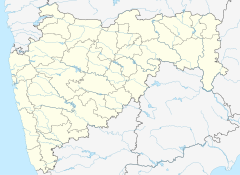
Back معبد فى تسعه معبد ARZ বিঠোবা মন্দির Bengali/Bangla विठोबा मन्दिर HI Kuil Witoba, Pandharpur ID ವಿಠ್ಠಲ ದೇವಸ್ಥಾನ, ಪಂಢರಪುರ KN പണ്ഢർപൂർ വിഠോബാ ക്ഷേത്രം Malayalam विठ्ठल मंदिर (पंढरपूर) MR ବିଠୋବା ମନ୍ଦିର OR Świątynia Withoby w Pandharpurze Polish பண்டரிபுரம் பாண்டுரங்க விட்டலர் கோயில் Tamil
This article needs additional citations for verification. (April 2015) |
| Vithoba Temple | |
|---|---|
 Shri Vitthal-Rukmini Mandir | |
| Religion | |
| Affiliation | Hinduism |
| District | Solapur |
| Deity | Vithoba Rakhumai |
| Festivals | Aashadhi Ekadashi, Kartiki Ekadashi. |
| Location | |
| Location | Pandharpur |
| State | Maharashtra |
| Country | India |
Location in Maharashtra | |
| Geographic coordinates | 17°40′N 75°20′E / 17.67°N 75.33°E |
| Architecture | |
| Type | Hoysala Architecture |
| Creator | Vishnuvardhana, Hoysala King[1] |
| Completed | 1108–1152 CE |
| Part of a series on |
| Vaishnavism |
|---|
 |
The Vithoba Temple, officially known as Shri Vitthal-Rukmini Mandir (Marathi: श्री विठ्ठल्-रूक्मिणि देऊळ), is a Hindu temple in Pandharpur, in the Indian state of Maharashtra.[2] It is the main centre of worship for Vithoba, a form of the god Vishnu or Krishna, and his consort Rakhumai. It is one of the 108 Abhimana Kshethram of Vaishnavate tradition.[citation needed] The temple was built by King Vishnuvardhana of Hoysala Empire between 1108 and 1152 CE upon being convinced by the historical figure Pundalik. Also, there is an inscription in the temple, of a Hoysala King Vira Someshwara dating back to 1237 CE, which grants the temple a village for its upkeep.[3] It is the most visited temple in Maharashtra. The Warkaris start marching from their homes to the temple of Pandharpur in groups called Dindi (procession) to reach on Aashadhi Ekadashi and Kartiki Ekadashi. A dip in the holy river Chandrabhaga, on whose banks Pandharpur resides, is believed to have power to wash all sins. All the devotees are allowed to touch the feet of the idol of Vithoba. In May 2014, the temple became the first in India to invite women and people from backward classes as priests.[4][5][6][7][8]
Although parts of the temple date to the 12th or 13th century, the existing structure mainly dates to the 17th century or later, and reflects the later Deccan style, with dome motifs and lobed arches.[9] Attempts were made to destroy the temple by Afzal Khan, however the original central figure of the shrine was protected by the Brahmin priests Badve while Afzalkhan destroyed a similar idol.
- ^ "The Great Pandharpur Pilgrimage". Live History India. 3 July 2017.
- ^ Cite error: The named reference
:0was invoked but never defined (see the help page). - ^ "The Great Pandharpur Pilgrimage". Live History India. 3 July 2017.
- ^ Vishwas Waghmode (29 May 2014). "Caste no bar: Women, non-Brahmins will be priests in Pandharpur temple". Firstpost. Retrieved 30 August 2018.
- ^ Amruta Byatnal (23 May 2014). "Pandharpur temple allows women, men of all castes as priests". The Hindu. Retrieved 30 August 2018.
- ^ Daily News & Analysis (15 May 2014). "Athawale slams Sanatan for opposing Dalit priest in temple". Dnaindia.com. Retrieved 29 July 2015.
- ^ "First time in 900 yrs, Vitthal Rukmini temple may get non-Brahmin priests". The Indian Express. 6 May 2014. Retrieved 29 July 2015.
- ^ "Lord Vithoba temple makes history by having women and lower-caste priests". IANS. news.biharprabha.com. Retrieved 9 May 2014.
- ^ Michell, George, The Penguin Guide to the Monuments of India, Volume 1: Buddhist, Jain, Hindu, p. 386, 1989, Penguin Books, ISBN 0140081445
